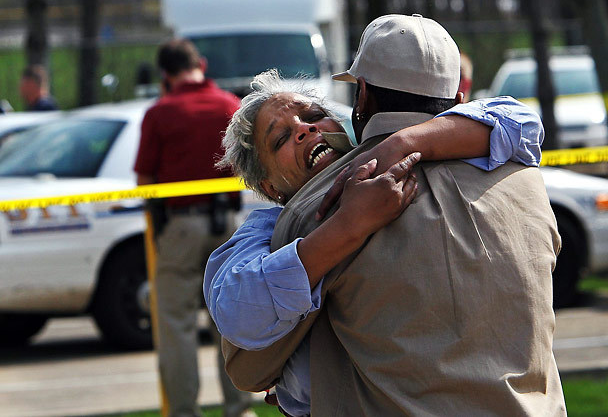The anguish displayed in this photograph is palpable. And if one takes time with the image it is hard not to feel this woman’s grief. But of course the image is not so unlike so many similar representations of pain and sorrow—both foreign and domestic—and it is not surprising that we would be unlikely to linger over the image. And truth to tell, while I did come across it in a slide show at a mainstream regional newspaper, it has not achieved a great deal of national circulation. Therein lies its importance.
The woman is the mother of a twenty four year old male who was found, with three others, shot to death “execution style” in an Akron, OH, townhouse. Numbers here are hard to know with exactitude, but according to the interactive website at Slate, he is the 3,788th person to be killed by gun shot since the tragedy in Newtown, CT. That is approximately twenty five people per day. Or to take a different measure of the magnitude, that is 811 more than the number of people killed in the 9/11 attacks. This mother’s grief is no doubt personal, but it is not solitary. It is shared by the parents and loved ones of at least 3,787 others in the past four months, and who knows how many in the months ahead. The problem is that there is no way for us to see them in their collectivity, to host or witness vernacular memorials to their loss of the sort that cropped up spontaneously around Ground Zero, or to publically memorialize their loss in the whole. All we have are fragmented, individual images of the private grief of their closest loved ones. And because that grief is private—even if made public in images such as the one above—we are inclined to look away or ignore it. One important dimension of the significance of events like Sandy Hook is that they animate a profound public presence to problems that otherwise remain private and hidden from the public eye.
Those who opposed the recent effort to legislate even modest federal gun controls laws were fond of arguing that we should not politicize the horrific event that took place at Sandy Hook Elementary School; the situation there, they argued, was so fraught with emotion that it would be irrational to respond to this one incident as if in kneejerk fashion. Admittedly, kneejerk responses are almost never productive, and I am inclined to resist purely affective responses to social and political crises, but to ignore the public emotional force of a near constant, sustained and growing problem is, well, thoroughly irrational. But of course, this is exactly what forty six members of the U.S. Senate did this past week when they chose—in the most cowardly of fashion—to vote against a modest, bipartisan plan supported by 90% of the American people to require background checks for online and gun show sales. The senatorial opposition supposedly was based on an absolutist interpretation of the 2nd Amendment—a standard that we have never maintained for any other constitutional amendment, including the vaunted 1st Amendment.
The photograph above is not the last one of its genre that we will see in the days, weeks and months ahead. And each time we encounter such an image we need to force ourselves to avoid the impulse to look away as if to honor and respect the privacy of personal loss and grief being experienced; rather, we need to see and witness in such images the public tragedy that is accumulating, one death at a time. And if we can force our legislators to witness and respond to the images each time one occurs, well, all the better.
Photo Credit: Ed Suba, Jr./AP Photo

Thank you. I keep thinking that one of the things we need to do is make the victims of gun violence more visible and more palpable, something along the lines of the AIDS quilt. It is easy to forget the scope of the tragedies when we don’t see the effect lying before us in its entirety.